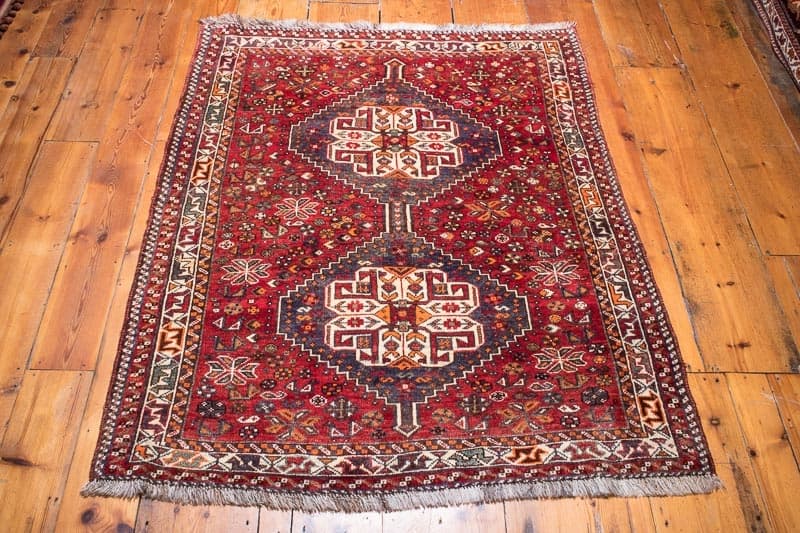
True Persian - and more generally, Oriental - rugs are hand-woven from wool fibers. The combination of the incredibly durable material and the care and attention that goes into their creation produces a rug of extraordinary longevity. If cared for properly that Persian rug you bought recently will not just outlive you, it could outlive your children and their children and their children and, well, you get the picture. Unfortunately, hand-crafted Persian rugs don't typically come with an owner's manual. So in order to make things a bit easier on you we thought we'd take a quick look at a few Oriental rug cleaning issues we run into pretty regularly.
Some Known Persian Rug Cleaning Issues
Owners of Persian and Oriental rugs often come to us with questions and issues related to their beautiful investments. Those questions and issues cover the entire spectrum of possibilities. But there are a few that come up more than others. So we're going to look at them now.
Question: How do I Deal with Spills and Stains on a Wool Rug?
People have been asking this question for literally thousands of years. It's nice to know your new Persian rug may well become a precious family heirloom. It's not so nice to think of it existing for the next 200 years with a big wine stain on it that undermines its value. When it comes to spills and stains the first thing to know is that wool is naturally moisture-resistant.
The next thing to know, however, is this: if a liquid is allowed to remain in contact with wool long enough, it will sink in. So, wool is moisture-repellent in the short term, but absorbent in the long term. The obvious implication of these facts is that, if you get on the rug cleaning ball fast enough, it's likely you can prevent a spill from turning into a stain.
We advise having a spray bottle always on hand that's filled with 50% water and 50% white vinegar. As soon as the spill occurs break out the spray bottle and spray the affected area until it's good and damp. Then take a clean, white, cotton towel and blot up the spill. Moisten and blot again if necessary to remove all traces of the spill. Then elevate the affected part of the rug and let it dry completely before returning it to the floor to be walked on.
Issue: Persian Rugs Don't Look Dirty Until They're Filthy
Because of the way they're made Persian and Oriental rugs are really good at trapping dirt way down inside. You won't see any of this by looking at the surface. But if you haven't submitted the rug for Persian or Oriental rug cleaning in a while rest assured; the dirt is there. By the time enough of it accumulates to become visible the rug is not just dirty, it's filthy.
We see this all too often. By the time the customer comes to us for Persian rug cleaning there are literally pounds of dirt trapped inside the fibers. Not a light dusting of dirt. Pounds of it. But that's not the worst of it really. The worst of it is that every time someone stepped on this filthy rug that dirt was ground into both the wool fibers and the cotton base of the rug.
All this grinding can create bare spots and dull areas where the color is ground off. There may be loose fibers as well. In some cases there might even be holes in the base. The easiest way to prevent this from happening is to vacuum the rug regularly, with the vacuum set on high. You'll never get all the dirt out, but you'll likely prevent serious dirt-related damage.
Question: What Are Those White Spots?
It's not all that unusual for older Persian and Oriental rugs to begin sporting white spots. These intermingle with the colors and patterns owners are familiar with and cause them to pick up their phone and call us. Some are convinced the rug is defective. Others wonder if someone sprinkled bleach on the rug. But mostly, people are just confused.
The fact is, these spots have always been there. They were either hiding beneath the long fibers of the pile, or they had been touched up with color by the rug maker in order to hide them. And now, after years of rug cleaning, that touch-up color has come off. “But what are they?” You ask. They're remnants of the production process. Small knots created when the cotton used to create the foundation ran out and a new string had to be tied to the end, creating a knot.
You can either accept them as a natural side effect of the aging process. Or you can have an expert colorist attempt to retouch them to make them blend in. Or you can have a rug restorer try and pull them through the back of the rug. If you choose to have them colored or pulled through the back of the foundation make sure you employ a qualified expert to do the job.
The Bottom Line
Persian and Oriental rugs are amazing examples of human artistry at its best. But they come with a unique set of potential issues attached. We hope you found the above information helpful. And if you need Persian rug cleaning make sure to contact the pros at Steve's Carpet Care & Restoration.
